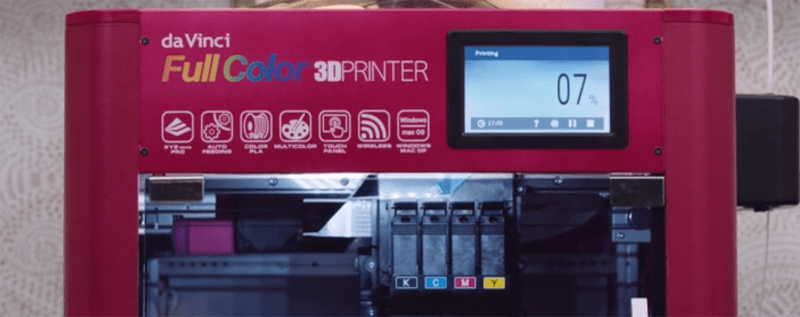XYZ Printing, makers of the popular da Vinci line of 3D printers, have just released one of the holy grails of desktop 3D printing. The da Vinci Color is a full-color, filament based printer. How does this work? A special filament (Color PLA, although this filament is white in color) is extruded through a nozzle like any other 3D printer. Color is then added layer by layer by a system of inkjets in the head of the printer. Yes, it’s a full-color 3D printer, and yes, people have been suggesting this type of setup for years. This is the first time it’s been made real.
The specs for this printer are about what you would expect from any other filament-based printer in 2017. The build volume is 200 x 200 x 150mmm, the print bed has auto-leveling (although strangely doesn’t have a heated bed), and the user interface is a 5-inch color LCD. The da Vinci Color is available for preorder right now for $2,999.
You can check out a few pics of samples printed on the da Vinci Color below:
In terms of brand recognition and XYZ Printing, their DaVinci is a somewhat surprising footnote in the history of desktop 3D printing. XYZ Printing’s da Vinci was one of the first cheap 3D printers with closed firmware, chipped filament, and a slightly terrible user interface. Nevertheless, the da Vinci was cheap and it could be hacked, turning it into a somewhat respectable printer.
As with any advancement in the state of desktop 3D printing, it must be mentioned that this is not. Color printing has been done before by members of the Open Source community. The exact same thing was done years ago with Sharpies, and I know RichRap experimented with markers and dye earlier than this, but I can’t find a reference. Full-color inkjets have been used in the past to create 3D prints, although these are powder-based printers, not filament printers. That doesn’t mean color printers can’t use filament; [Prusa]’s multicolor extruder is shipping soon, the Mosaic Palette splices filament to create multicolor prints (another RichRap invention circa 2011), and [Daren Schwenke]’s Arcus 3D has a mixing hot end that can create any color from CMYKW filament. There are many other solutions to full-color 3D printing that have been invented over the years, let us know your favorites in the comments below.

























Does the ink cost 3x as much as regular printer ink and claim it’s empty at only half way like XYZPrinting’s “custom” filament?
with the multiple workarounds and several models where custom filament is directly supported it isnt excactly unavoidable…
This is inkjet. Soon they will be available such that the printer costs less than the ink. Dumb people will keep buying new ones thinking the ‘free’ ink they get with it is a cost savings. The cartridge that comes with the printer though will be a small fraction of full though.
All I’m hearing is: cheap source of parts. Oh, and sheer waste of producing goods for profit to for them to mostly end up in landfill buuut if you can’t beat ’em, upcycle ’em…
NICE!! Looking forward to this tech becoming affordable (and open source)
They probably patented it. :-(
I doubt that’ll hold up. As the article said, there’s been lots of mention of this before, that would count as “prior art” too, I think.
But if this printer would come down in price I’d probably get one. Just not for 3k. I’m sure it can be hacked just as the previous ones were.
I was under the impression that the patent rules have been changed from first to invent to first to file. Did that not actually happen? Whoever just files a patent owns the invention these days if it did.
It still can’t be public knowledge to be patentable, although USPTO does not really seem to have any public knowledge.
I sure would if I were in their shoes.
Probably can’t patent something that has been shown in the marketplace prior to the application. You must be the original inventor to obtain a patent and, by definition, since it it has been out and available already, I think it would not qualify. Now, it there is some “new” technology or a proprietary process then maybe that could be patented. I am not an attorney and do not give legal advice, this is just my opinion.
Look at the size of the shit that dinosaur took! He must have vacated nearly his whole torso!
“Feels good man”
It’s better than nothing I guess, and it’s an interesting technological development that could continue to improve in the future. However, I must admit that most of the example prints look pretty bad, with lots of ugly banding, a weird lack of color on just-off-horizontal surfaces, and generally poor color calibration (either not saturated enough or extremely saturated). But again, it’s certainly an interesting development and I’d like to see where it goes.
I think I’ll wait for the Laserjet one to hit the shelves.
Oh snap! I was literally discussing how to do this kind of thing yesterday. My approach was toner based to avoid any possible patents from 3D Systems who have already made similar full color 3d printers.
Um, the sharpie approach was single color only.
Cool, I had been experimenting with something similar except using a felt marker to color the filament as it was going in to the J-Head. worked prety well but however much like their version it seems to suffer from color washout. once the part was printed it seemed to have the normal strength properties that one would expect.
There is a chepear option: http://www.spitstec.nl/colorpod
According to their Youtube video, they don’t show how it works or while it’s printing, but apparently it can get you laid.
PLA, meh.